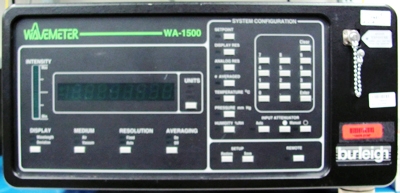
|
|
The Burleigh WA-1500 system employs Burleigh’s proven scanning Michelson interferometer-based WAVEMETER technology to determine the absolute wavelength of a laser by comparing its interference fringe pattern with that of a built-in HeNe laser wavelength standard. Three versions of the WA-1500 WAVEMETER are available for different operational wavelength ranges: visible (VIS: 400-1100 nm), near infrared (NIR: 600-1800 nm), and infrared (IR: 1.5-4 µm). Each version includes a photodetector and a beamsplitter optimized for its operational wavelength range. Conversion from one wavelength range to another is accomplished simply by replacing the photodetector and beamsplitter. This WAVEMETER system includes two standard methods of laser input. A laser beam from an optical fiber enters through a standard FC/PC (FC/APC optional) connector on the front panel. Or, a free space laser beam enters through an aperture on the side of the system. A flip mirror is used to switch from one input method to the other. The fiber-optic input is used primarily for visible and near infrared wavelengths. Specifications. Wavelength Range: 400 - 1100 nm (VIS), 600 - 1800 nm (NIR), 1.5 - 4 µm (IR). Absolute Accuracy: ± 0.2 ppm, ± 0.0002 nm @ 1000 nm, ±0.002 cm @ 10,000 cm, ± 0.06 GHz @ 300,000 GHz. Display Resolution: 0.0001 nm, 0.001 cm, 0.01 GHz. Units: nm or cm (vacuum or air), GHz. Optical Input Signal Sensitivity: 20 µW (VIS, NIR), 1 mW (IR). Maximum Optical Input Signal: 2 mW (VIS, NIR), 100 mW (IR). Measurement Update Rate: 4 Hz. Optical Input Fiber: FC/PC connector standard, FC/APC connector optional. Analog Output: ± 5 volts proportional to wavelength deviation. Instrument Interface: RS-232 standard, GPIB/IEEE-488 optional.
|